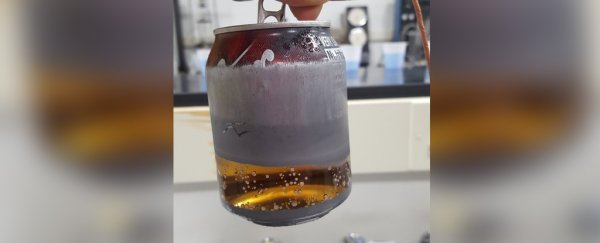The world produces a staggering 180 billion aluminium cans every year, but it's a safe bet many of the people consuming those beverages don't know about a hidden material concealed inside the metal cylinders.
For decades, aluminium can manufacturers have lined the inside of their cans with plastic. Why? Well, it's to protect the beverage from the can… and also to protect the can from the beverage.
By insulating the drink inside the can from the metal can itself, the lining prevents acids and other chemicals in the beverage from corroding the aluminium – while at the same time preventing the aluminium from interacting with the liquid and affecting its flavour.
Different manufacturers use a number of different kinds of polymer or epoxy liners for this purpose, and the amazing thing is, it's possible to actually reveal these hidden liners inside the can by dissolving the aluminium on the outside.
A viral video by science education company MEL Science reveals how easy it is to do this – but please be aware, as the video itself states, you shouldn't attempt this at home.
That's because the technique involves a dangerous chemical, and it also produces fumes, so it requires a very well-ventilated area (others strongly advise only doing it with a fume hood).
Nonetheless, the technique is relatively simple to perform.
All you need is an aluminium can, sandpaper, a large beaker that the can will easily fit inside of, drain cleaner (containing sodium or potassium hydroxide solution), a wooden rod, and a large glass container – plus protective gear of course, including gloves, glasses, and a mask.
As the video explains, you simply buff the external surface of the can with the sandpaper, until its paint is removed and you're left with a silver, shiny cylinder.
Then, you can open the can with the ring-pull, and use a wooden rod to suspend the can inside the beaker. Drain cleaner is then poured inside the beaker, surrounding the can.
After two hours or so, the aluminium should be completely dissolved, and you're left with what almost looks like an optical illusion: a squidgy, seemingly invisible cylinder of soft drink, contained inside the transparent plastic liner.
Of course, if you do attempt this at home with all the right equipment and supervision – not that you should, mind you – make sure you don't drink the beverage, as it may be contaminated by other chemicals at this point.
While the soda liner is something of an industry secret, it's a known thing in the scientific community, and science enthusiasts have been showing off the results of this technique for years online, revealing the hidden plastic concealed in the can.
A chapter in a corrosion book talked about the liners inside soda cans. I dissolved a can with NaOH to reveal it. pic.twitter.com/2Ed46DxjiB
— John Carmack (@ID_AA_Carmack) April 19, 2015
The use of certain plastics in these liners has also been a cause of scientific concern, with some research suggesting BPA-lined cans could be linked to health problems.
For that reason, much of the industry has moved away from BPA liners, although some companies, including the most obvious soft drink maker, seem to still be holding out.
For more on this weird and little-known topic, check out this awesome book excerpt in Wired.
